Volatile Organic Compounds: The Health Dangers of VOCs, Where They are Hiding & How to Avoid Them
by www.SixWise.com
Products that you use in your home and office every day emit
gases that can harm your health, both right away and after
extended exposure. These gases are known as volatile organic
compounds (VOCs), and they're emitted from a whole slew of
items so much so that there's a pretty good chance your new
home, office, car -- even that shiny new airplane you took
your last business trip in -- are literally bathing you in
a chemical cocktail.
| Building a new home? VOCs in the indoor air of
new buildings is on average 20 to 40 mg per m 3.
Adverse health effects may be felt at 10 mg per
m 3. |
 |
|
According to the Environmental Protection Agency, concentrations
of VOCs are consistently up to 10 times higher indoors than
outdoors. Other studies have found that certain organic compounds
average levels two to five times higher in indoor air than
outdoor air.
What is most shocking, however, is that immediately after
using certain products, such as paint stripper, studies have
found that VOCs may be 1,000 times higher than background
outdoor levels.
VOCs: Here, There and Everywhere
Part of the problem with VOCs is that they are so prolific
in our environment.
|
Sources of VOCs Include ...
- Paints
- Paint strippers and other solvents
- Wood preservatives
- Aerosol sprays
- Cleansers and disinfectants
- Moth repellents
- Air fresheners
- Stored fuels and automotive products
- Hobby supplies
- Dry-cleaned clothing
- Varnishes
- Newspaper
|
- Cooking
- Vinyl floors
- Carpets
- Photocopying
- Upholstery fabrics
- Adhesives
- Sealing caulks
- Cosmetics
- Vehicle exhaust
- Pressed wood furniture
- Tobacco smoke (secondhand smoke)
|
|
New materials, such as those used in new homes and cars,
tend to outgas more VOCs than older materials, and may decrease
in VOCs as time goes by.
For instance, according to researchers of Australia's Commonwealth
Scientific & Industrial Research Organization (CSIRO),
"Total VOCs in the indoor air of new buildings is on
average 20 to 40 mg per m 3, while established buildings have
VOC levels generally below 1 mg per m 3."
In fact, it is the heavy mixture of VOCs that gives new vehicles
their characteristic new car smell. Automakers do try to limit
the most potent VOC-emitting items; however, the result is
that the cars may no longer have the smell many consumers
love -- good for your health, but potentially bad for business.
Automakers have come up with a quick fix, though, and may
add artificial "new car smell" or "treated
leather" fragrances to vehicles.
VOCs' Health-Harming Ways
While some VOCs cause no known health effects, others are
known to be highly toxic. Their effects vary and are dependent
upon several factors including:
-
The length of time you're exposed to them
-
The rate at which the VOC is off-gassed
-
The building's ventilation capacity
-
Whether you're exposed to a combination of chemicals
(these effects are largely unknown)
|

Perchloroethylene is a cancer-causing VOC used in dry
cleaning. Look for environmentally friendly cleaners
that do not use this toxic chemical.
|
Acute symptoms of VOC exposure include:
However, over time, VOCs can lead to many serious conditions
including:
People with respiratory problems such as asthma, young children,
the elderly, and people with heightened sensitivity to chemicals
may be more at risk from VOC health effects. CSIRO found,
though, that anyone could experience acute symptoms at exposure
to concentrations above about 10 mg per m3.
Remember, new buildings may average VOC levels at 20 to 40
mg per m 3, and the CSIRO report found total VOC concentrations
for new cars to be as high as 64 mg per m3 of air. After a
few weeks, this level fell to 2.1 mg per m3, and to about
1.5 mg per m3 after six months.
One caveat, as the temperature rose, so did the total VOC
concentrations in the cars.
|
Enviro-Rite Carpet & Upholstery
Cleaner: A Clean Home, Not a Toxic One
 Using
all-natural cleaning products is essential to keeping
VOCs and other toxic vapors out of your home's air --
and your family's lungs. Intended for use on both carpet
and upholstery, Enviro-Rite Carpet Cleaner is an excellent
vegetable-based cleaning concentrate that replaces all
petroleum-based formulations used in hot water, extractor-type
cleaning equipment. Using
all-natural cleaning products is essential to keeping
VOCs and other toxic vapors out of your home's air --
and your family's lungs. Intended for use on both carpet
and upholstery, Enviro-Rite Carpet Cleaner is an excellent
vegetable-based cleaning concentrate that replaces all
petroleum-based formulations used in hot water, extractor-type
cleaning equipment.
This truly unique cleaner is specially developed by
and for people with allergies, asthma and chemical sensitivities.
EnviroRite Carpet Cleaner is:
- FREE of common respiratory and skin irritants.
- Made with naturally occurring renewable resources,
containing no petrochemicals or added dyes or fragrances.
- Safe for use in closed environments and does not
compromise indoor air quality.
- Free rinsing, leaving behind no irritating residue.
- A low-foaming formulation that is not high in caustic
pH. Diluted correctly, the pH is 7.5.
- An environmentally responsible product.
- Never tested on animals.
Learn
More About Enviro-Rite Carpet & Upholstery Cleaner
and Order Yours Now!
|
Reduce Your VOC Exposure Now
According to the EPA, "At present, not much is known
about what health effects occur from the levels of organics
usually found in homes." That said, reducing your exposure
as much as possible is a prudent measure to protect the health
of yourself and your loved ones. Here are a number of tips
that you can put into action today:
-
Use only natural cleaning supplies in your home. At Sixwise.com,
we carry an entire line of environmentally friendly, petrochemical-free
cleaning products for your upholstery, carpets, glass,
dishes and more -- and, as it contains no toxic ingredients,
it won't compromise your indoor air quality.
-
Purchase new home and office products that contain low
or no VOCs (look for Environmentally Preferable Purchasing).
-
Use potentially hazardous products outside or in areas
equipped with exhaust fans. At the very least, open windows
and use fans to keep air circulating.
-
Watch the temperature and humidity: as these increase,
so will the off-gassing of chemicals.
-
Filter your home's air with a high-quality air filter.
-
Dispose of partially used chemicals. Vapors can leak
even from closed containers. When you purchase chemicals,
purchase only the amount you will use right away. Contact
your city or county for proper disposal of household hazardous
wastes.
-
Choose an environmentally friendly dry cleaner, like
Greener Cleaners. Perchloroethylene, the chemical most
widely used in dry cleaning, is a VOC known to cause cancer
in animals. Studies have found that people do breathe
in low levels of this chemical while wearing dry-cleaned
clothing and in homes where the clothing is stored. Environmentally
friendly cleaners do not use this chemical, so ask about
it before dropping your clothing off for cleaning.
Recommended Reading
Organophosphates:
What You Don't Know Can Indeed Hurt You
The
Toxic Chemicals Most Linked to Depression
Sources
U.S.
EPA: Sources of Indoor Air Pollution
Minnesota
Department of Health: VOCs in Your Home
Chemical
and Engineering News: New Car Smell